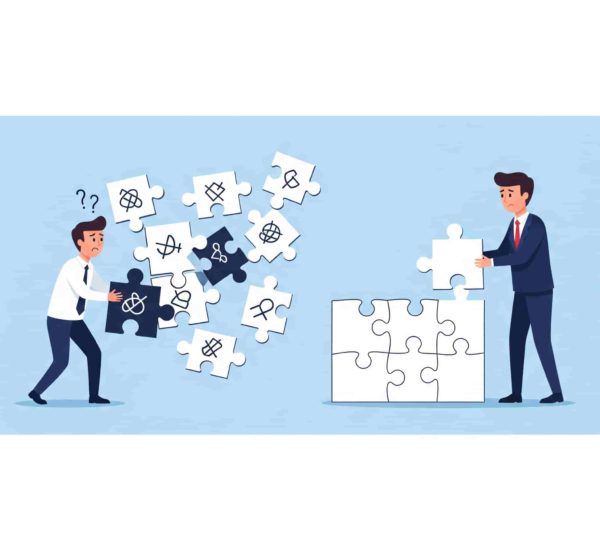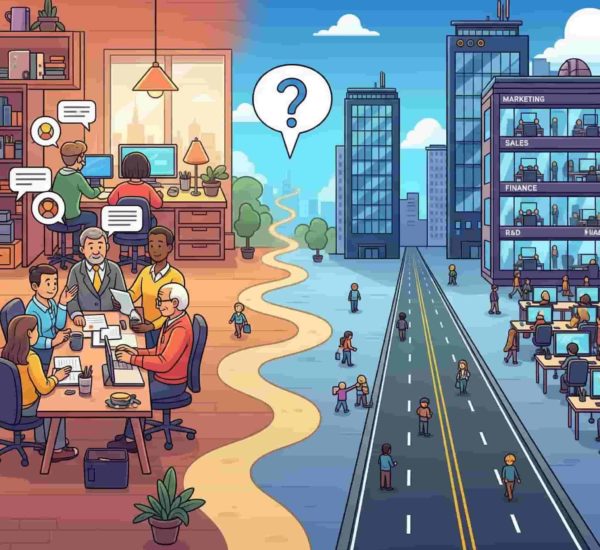In the world of human resources, traditional methods of managing talent, fostering engagement, and evaluating performance are being reshaped by algorithmic HR. With data-driven algorithms at the helm, businesses are unlocking smarter, faster, and more equitable ways to manage their workforce.
Picture a hiring process that doesn’t rely solely on resumes and gut feelings but instead uses predictive analytics to find the best candidate. Or imagine crafting employee engagement strategies based on real-time insights instead of one-size-fits-all surveys. These advancements, powered by algorithms, are revolutionizing HR practices, making processes more efficient and decisions more informed.
However, the shift to algorithmic HR isn’t without its hurdles. While algorithms promise objectivity and efficiency, they also raise concerns about transparency, bias, and privacy. Striking the right balance between technological innovation and preserving the human element is a challenge that organizations must navigate as they embrace this evolution.
This blog dives into the rise of algorithmic HR, exploring how it’s reshaping talent acquisition, workforce management, and decision-making. Let’s unpack the opportunities and challenges that come with this new frontier in human resources.

How Google Redefined Data-Driven HR Practices
The journey of integrating algorithms into HR began with trailblazers like Google. By rebranding its HR department as “people operations” and relying on data analytics for workforce decisions, Google set the stage for algorithm-driven HR.
Fast forward to today, and artificial intelligence (AI) has become a game-changer for HR across industries. AI adoption in workplaces has skyrocketed, with organizations reporting significant productivity gains. Many businesses credit AI tools with eliminating inefficiencies and enabling teams to focus on high-value tasks.
In HR, AI now plays a crucial role in human capital management (HCM), spanning areas like payroll, recruitment, onboarding, and workforce analytics. These tools give HR professionals actionable insights to make strategic decisions that impact the workforce positively.
Google’s early adoption of data-driven practices demonstrates the power of these tools. As businesses continue to embrace algorithmic HR, the focus should remain on continuous learning and innovation. By leveraging algorithms effectively, organizations can also enhance employee well-being and satisfaction, building a more engaged and productive workforce.
The Role of Algorithms and Workforce AI in Transforming HR
Once reserved for areas like marketing, sales, and customer service, algorithms are now a cornerstone of HR innovation. Drawing inspiration from companies like Google, these tools work much like Google Analytics, but instead of monitoring website traffic, they analyze employee and candidate data.
The beauty of data-driven HR, often referred to as people analytics, lies in its flexibility. Organizations can tailor algorithms to address specific metrics and challenges, making it easier to tackle unique workforce issues.
The impact of this approach is evident. Many companies now use people analytics to address critical areas such as employee retention and turnover. These tools also enhance recruitment, optimize benefits, improve employee engagement, and elevate performance management.
However, the rise of AI in HR brings its challenges. As regulations around AI evolve in the US, companies must stay ahead by prioritizing compliance and ethical responsibility.
To integrate AI successfully and responsibly, businesses should:
- Perform regular audits to ensure algorithms remain accurate and unbiased.
- Obtain clear consent from employees for AI-driven processes.
- Create robust HR policies that align with AI regulations.
- Train HR teams to use AI responsibly.
- Verify that third-party vendors meet compliance standards.
AI and algorithms are transforming HR’s potential, but their success hinges on combining innovation with ethical practices. By maintaining this balance, businesses can unlock new levels of efficiency and fairness while keeping the human touch at the heart of their HR strategies.
The Advantages of Algorithmic HR and AI
The integration of algorithms and artificial intelligence (AI) into HR is transforming workforce management, offering organizations a range of tangible benefits. By harnessing the power of data and automation, businesses can optimize operations, make smarter decisions, and elevate the employee experience.
Here’s a closer look at how algorithms and AI are reshaping HR practices:
Smarter Recruitment and Hiring
AI tools can analyze resumes, match candidates to specific job requirements, and even predict a candidate’s success in a role. This not only accelerates the hiring process but also improves job fit, leading to stronger retention rates and better hiring outcomes.
Boosted Employee Retention
With the help of people analytics, HR teams can identify patterns in employee turnover and take proactive steps to address potential issues. Algorithms highlight factors like job satisfaction, workload challenges, or team dynamics, enabling HR to implement timely solutions.
Data-Driven Decision-Making
Algorithms process extensive HR data to uncover meaningful insights. Leaders can then make evidence-based decisions on critical areas such as workforce planning, resource allocation, and performance management.
Personalized Employee Engagement
AI enables real-time monitoring of employee engagement and recommends targeted strategies to enhance morale. Insights from pulse surveys or feedback data can guide initiatives to improve satisfaction and foster a positive workplace culture.
Simplified Administrative Tasks
By automating repetitive duties like payroll, benefits management, and scheduling, AI frees up HR professionals to concentrate on strategic priorities, boosting team productivity and efficiency.
More Substantial Compliance and Risk Management
AI tools stay updated on regulatory changes, helping HR maintain compliance with laws and policies. This reduces the risk of non-compliance and shields the organization from potential legal challenges.
Enhanced Diversity and Inclusion
When designed thoughtfully, algorithms can minimize unconscious bias in recruitment and promotion processes. By focusing on objective data, AI supports a more equitable and inclusive workplace.
While the advantages of algorithms and AI in HR are undeniable, their effectiveness depends on thoughtful implementation. Businesses must prioritize transparency, address ethical considerations, and equip teams with the training needed to use these technologies responsibly. By balancing innovation with a human-centered approach, organizations can unlock the full potential of AI in HR.
Challenges and Concerns with Algorithmic HR Strategies
Innovation brings progress, but it also introduces challenges—and algorithm-driven HR is no exception. While AI and data analytics have revolutionized HR processes, they come with ethical, legal, and operational complexities that demand thoughtful consideration.
Ethical Implications
Algorithm-driven HR raises serious ethical concerns. Chief among them is the risk of unintended bias. While AI seeks to eliminate human subjectivity, its accuracy depends on the data it is trained on. If that data reflects historical prejudices, those biases may become ingrained, perpetuating systemic inequalities. Moreover, using AI for decisions that directly impact people—such as promotions or terminations—raises moral questions about fairness, transparency, and accountability.
Risks of Inherent Discrimination
Algorithms are only as unbiased as their design. Poorly crafted systems might emphasize irrelevant or harmful traits, leading to discriminatory practices. For example, if an algorithm disproportionately values criteria tied to specific demographic groups, it can exclude equally qualified candidates. Such errors undermine diversity and fairness, potentially marginalizing entire groups within the workforce.
Privacy and Data Protection Concerns
The reliance on vast datasets for algorithm-driven HR creates significant privacy challenges. These systems often handle sensitive personal information, increasing the risk of data breaches or misuse. Without strict data protection protocols, employees and candidates may lose trust in how their information is collected, stored, or analyzed. Privacy regulations like GDPR and CCPA heighten the stakes, as non-compliance can result in fines and reputational damage.
Transparency and Explainability
The “black box” nature of many algorithmic systems makes their decision-making processes hard to understand. This lack of transparency can lead to mistrust, as employees and HR professionals may question the rationale behind AI-driven outcomes. Without clear explanations, it becomes challenging to validate, trust, or challenge these decisions. Transparent and explainable systems are essential for maintaining accountability and confidence.
Over-Reliance on Automation
While automation can optimize repetitive tasks, over-reliance on AI risks removing the human touch from HR. Employee relations require empathy and nuanced understanding—qualities no machine can replicate. When decisions are perceived as being made solely by machines, employees may feel undervalued or dehumanized, eroding morale and trust.
Legal and Regulatory Risks
The legal landscape surrounding AI in HR is rapidly evolving. Governments are introducing stricter regulations to ensure ethical AI usage, and organizations must stay ahead of compliance requirements. Failure to do so can result in lawsuits, penalties, and reputational harm. Businesses also face the challenge of balancing innovation with adherence to ethical and legal standards.
Resistance to Change
Adopting algorithmic HR tools can face pushback from employees and HR professionals alike. Concerns about job security or discomfort with AI may lead to resistance. Providing thorough training and demonstrating how AI enhances, rather than replaces, their roles is key to gaining buy-in and fostering collaboration.
Cost and Implementation Challenges
Deploying AI-powered HR solutions requires significant investment in technology, infrastructure, and training. Smaller businesses may struggle to justify the cost relative to the benefits. Moreover, poorly implemented systems can cause more harm than good, leading to inefficiencies and frustration.
Striking the Right Balance
The challenges surrounding algorithmic HR highlight the importance of balancing innovation with human judgment. Organizations that proactively address ethical, legal, and operational hurdles can harness the full potential of AI while safeguarding fairness, transparency, and the human element that remains central to HR.

Best Practices for Implementing Algorithm-Driven HR
As more organizations turn to algorithmic HR strategies, it’s vital to follow best practices to reduce risks and maximize benefits. Here are key steps companies can take to use AI responsibly and effectively:
1. Ensure Diversity in Training Data
AI models are only as good as the data used to train them. To avoid biases, it’s crucial to use diverse, representative data. For example, if you’re training a system to screen job applicants, include data from various demographics to ensure fairness across genders, races, and age groups. This helps avoid scenarios where the system may unintentionally favor certain groups over others, ensuring decisions are equitable for all employees.
2. Regular Audits and Monitoring
Regular audits of your AI systems can uncover biases or problems early on. For example, conducting quarterly audits of your performance evaluation system can identify any patterns that disproportionately affect certain groups of employees. Monitoring also ensures your AI aligns with the organization’s goals and legal standards, adjusting when necessary to keep everything running smoothly.
3. Provide Transparency and Explainability
Building trust with your employees is essential when implementing AI in HR. Ensure your HR teams and employees understand how the AI makes decisions. For instance, if an AI system is used to recommend training programs for employees, explain how it selects those programs—whether it’s based on performance metrics, career growth potential, or other factors. Transparency helps hold AI accountable and fosters trust in the system.
4. Human Oversight and Collaboration
While AI can assist in data analysis, human judgment remains irreplaceable. HR professionals should always have the final say in key decisions, especially in sensitive areas like performance reviews or disciplinary actions. For example, if an AI system flags an employee for low performance, a human HR manager should review the context before any decisions are made. AI should complement HR professionals’ expertise, not replace it.
5. Develop Clear Ethical Guidelines
Establish ethical standards for AI usage in HR. Set boundaries around what data can be used, ensuring privacy protection, and ensuring decisions are fair. For instance, using personal data for performance tracking should only be done with explicit consent, and any AI-driven decisions should be explainable and justifiable. Ethical guidelines protect both employees and the organization from potential harm.
6. Train HR Professionals and Employees
Effective training ensures everyone can work with AI systems confidently. HR teams should receive training on how to use AI tools, while employees should understand how their data is used. For example, HR professionals can be trained to interpret AI-generated reports for identifying training needs, while employees should know how the system analyzes their performance data to avoid confusion or distrust.
7. Stay Compliant with Laws and Regulations
AI regulations and privacy laws are constantly evolving. It’s essential to stay up to date with legal requirements such as GDPR and CCPA. For instance, if your organization collects employee data to train AI, ensure you have the necessary permissions and safeguards in place to protect employee privacy and comply with regulations. Regularly consulting legal experts ensures compliance and avoids potential legal issues.
Last Word on Algorithmic HR
Although the challenges of algorithm-driven HR are real, they’re not insurmountable. Companies like Google have shown the value of AI in HR, and research consistently demonstrates its positive impact when used thoughtfully. By integrating AI with a focus on fairness, transparency, and oversight, organizations can unlock new efficiencies, helping them stay competitive and supportive of their workforce in today’s dynamic HR landscape.



